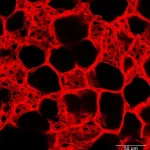(Press-News.org) ATLANTA — Influenza A viruses with induced resistance to a new candidate antiviral drug were found to be impaired in cell culture and weakened in animals, according to a study by researchers in the Center for Translational Antiviral Research at Georgia State University.
In a study published in PLoS Pathogens, the authors explored the developmental potential of 4’-fluorouridine (4’-FlU), a clinical drug candidate, for influenza therapy. They resistance profiled the compound against influenza viruses and mapped possible routes of viral escape, addressing specifically whether resistance affects viral pathogenicity and ability to transmit.
In previous studies, 4’-FlU demonstrated broad oral efficacy against seasonal, pandemic and highly pathogenic avian influenza viruses in cell culture, human airway epithelium cells and two animal models, ferrets and mice.
Seasonal influenza viruses pose a major public health threat, infecting nearly 1 billion people worldwide each year and causing millions to require hospitalization and advanced care. Annual flu vaccines provide moderate protection, but the benefit is marginal when vaccines are poorly matched with circulating virus strains or when novel, pandemic virus strains emerge.
While three different classes of antivirals are approved by the U.S. Food and Drug Administration for use against influenza, they each have a low genetic barrier against viral resistance. One of these classes is no longer recommended by the Centers for Disease Control and Prevention due to widespread presence of resistance mutations in circulating human and animal influenza A virus strains. Resistance has also been frequently observed to the other two classes of antivirals in human viruses.
“Developing novel therapeutics to mitigate seasonal influenza and improve preparedness against future influenza pandemics is an urgent priority because of pre-existing or rapidly emerging resistance of influenza viruses to approved antivirals,” said Carolin Lieber, first author of the study and a postdoctoral fellow in the Center for Translational Antiviral Research in the Institute for Biomedical Sciences at Georgia State.
“In this study, we tested the potential of 4’-FlU as an influenza drug and found that resistant influenza A virus variants are severely weakened in mice. In ferrets, these resistant variants are impaired in their ability to invade the lower respiratory tract and cause viral pneumonia, in addition to being transmission-defective or compromised,” Lieber said.
In cell culture, six different escape lineages with distinct mutations were found. The mutations adhered to three distinct structural clusters that are all predicted to affect the active site of the viral RNA-dependent RNA polymerase complex, leading to moderately reduced viral sensitivity to the drug, according to the study’s findings.
The study also found that oral 4’-FlU administered at the lowest efficacious dose (2 mg/kg) or elevated dose (10 mg/kg) overcame moderate resistance when mice were infected with a lethal amount of influenza virions. This was demonstrated by significantly reduced virus load and complete survival, the authors reported.
“We discovered that we could fully mitigate lethal infection with the resistant variants and viral spread with standard or five-fold elevated oral dose of 4’-FlU,” said Richard Plemper, senior author of the study, Regents’ Professor in the Institute for Biomedical Sciences and director of the Center for Translational Antiviral Research at Georgia State. “These results demonstrate that partial CA09 escape from 4’-FlU is feasible in principle, but escape mutation clusters are unlikely to reach clinical significance or persist in circulation.”
Additional authors of the study include Hae-Ji Kang, Megha Aggarwal, Jeong-Joong Yoon and Robert M. Cox of the Center for Translational Antiviral Research in the Institute for Biomedical Sciences at Georgia State; Nicole A. Lieberman, Elizabeth B. Sobolik and Alexander L. Greninger of the University of Washington Medical Center; and Michael G. Natchus of the Emory Institute for Drug Development and Emory University School of Medicine.
The study is funded by the National Institutes of Health’s National Institute of Allergy and Infectious Diseases.
To read the study, visit https://journals.plos.org/plospathogens/article?id=10.1371/journal.ppat.1011993.
END
Flu virus variants resistant to new antiviral drug candidate lose pathogenicity, study finds
2024-02-06
ELSE PRESS RELEASES FROM THIS DATE:
Microfluidic environments alter microbe behaviors, opening potential for engineering social evolution
2024-02-06
Microbes are social beings.
Much like humans, they communicate and cooperate with each other to solve problems bigger than themselves. In a microbial community, there will even be free riders, and others that police them.
So, what if researchers could influence their social evolution to promote certain behaviors? Doing so can be vital to solving many of today’s challenges such as combating infection and antibiotic resistance, developing microbial strategies for wastewater treatment or harvesting alternative energy sources.
A research group led by Dervis Can Vural, an associate professor in the Department of Physics and Astronomy at ...
Structural isomerization of individual molecules using a scanning tunneling microscope probe
2024-02-06
1. An international research team led by NIMS, the Osaka University Graduate School of Science and the Kanazawa University Nano Life Science Institute (WPI-NanoLSI) has succeeded for the first time in controlling the chirality of individual molecules through structural isomerization. The team also succeeded in synthesizing highly reactive diradicals with two unpaired electrons. These achievements were made using a scanning tunneling microscope probe at low temperatures.
2. It is usually quite challenging to control the chirality of individual molecular units and synthesize extremely reactive diradicals in organic chemistry, preventing ...
Moffitt study suggests improvements needed for patient-reported outcome data in genitourinary cancer clinical studies
2024-02-06
TAMPA, Fla. — Patient-reported outcomes are important indicators of how cancer drugs impact patients’ lives. By assessing the benefits and risks of drugs from a patient’s perspective, scientists and physicians can improve the development of patient-centered drugs and care. In a recent study published in eClinicalMedicine, part of The Lancet Discovery Science, Moffitt Cancer Center researchers demonstrate that there is a significant unmet need for improved analyses and reporting of patient-reported outcomes in genitourinary cancer clinical trials.
Health care professionals have realized that how a disease and its treatment ...
New EU-funded project "FOOD includes" aims to improve the inclusiveness and accessibility of adult education
2024-02-06
In December 2023, the new "FOOD includes" project funded by the European Commission started at the Center for Lifelong Learning at Johannes Gutenberg University Mainz (JGU). Over its 36-month term, the objective of "FOOD includes" is to increase take-up and improve the inclusiveness and accessibility of adult education. The project has been designed for adults with lower academic qualifications and migrants who are less likely to take advantage of continuing education and training opportunities. Therefore, the project focuses on activities revolving ...
New water-focused innovation engine aims to turn waste into wealth for Great Lakes region
2024-02-06
The waste in our water could soon generate new waves of clean energy development, job creation and economic growth across the Great Lakes thanks to a new regional innovation and economic development initiative launched by the U.S. National Science Foundation (NSF). The initiative will fund efforts to find new ways to recover clean water, nutrients and materials for clean energy technologies from wastewater — all while removing dangerous chemicals.
These efforts will be carried out by Great Lakes ReNEW, a collaboration of research institutions, universities, ...
Researchers breathe new life into lung repair
2024-02-06
In the human body, the lungs and their vasculature can be likened to a building with an intricate plumbing system. The lungs’ blood vessels are the pipes essential for transporting blood and nutrients for oxygen delivery and carbon dioxide removal. Much like how pipes can get rusty or clogged, disrupting normal water flow, damage from respiratory viruses, like SARS-CoV-2 or influenza, can interfere with this “plumbing system.”
In a recent study, researchers looked at the critical role of vascular ...
Promoting prosocial behavior in the classroom and beyond
2024-02-06
COLUMBIA, Mo. -- Christi Bergin has devoted 40 years of her life to helping teachers and their students. Throughout her career, she’s noticed two simultaneous trends in the field that seem to be connected: a rise in disruptive classroom behavior, and an exodus of teachers from the profession who leave due to stress and burnout.
To help combat these trends, Bergin, a professor emerita in the University of Missouri College of Education and Human Development, has focused her research on improving prosocial behavior — actions that show kindness, compassion, empathy and respect — in classrooms and communities.
Not ...
Perceptions of manhood and masculinities among disabled violently injured Black men in a hospital-based violence intervention program
2024-02-06
Black men with firearm-acquired disabilities face negative physical and psychological impacts on their manhood, independence and mobility, according to a Rutgers Health study.
The study, published in the American Journal of Men’s Health, explored the relationship between Black manhood/masculinities and firearm-acquired disabilities. Participants’ disabilities also impacted their perceptions of independence. Specifically, participants felt that they were a burden to their caretakers because of their reliance on them. This loss of independence ...
Two new freshwater fungi species in China enhance biodiversity knowledge
2024-02-06
Researchers have discovered two new freshwater hyphomycete (mould) species, Acrogenospora alangii and Conioscypha yunnanensis, in southwestern China.
This discovery, detailed in a study published in MycoKeys, marks the addition of these species to the Acrogenospora and Conioscypha genera, further enriching the diversity of freshwater fungi known in the region.
A research team consisting of Lu Li, Hong-Zhi Du and Ratchadawan Cheewangkoon from Chiang Mai University, Thailand, as well as Vinodhini Thiyagaraja and Rungtiwa Phookamsak from Kunming Institute of Botany, China, and Darbhe Jayarama Bhat from King Saud University, Saudi Arabia, employed comprehensive morphological ...
Apex predators not a quick fix for restoring ecosystems, 20-year CSU study finds
2024-02-06
A Colorado State University experiment spanning more than two decades has found that removal of apex predators from an ecosystem can create lasting changes that are not reversed after they return – at least, not for a very long time.
The study, funded by the National Science Foundation and published in Ecological Monographs, challenges the commonly held belief that the reintroduction of wolves to Yellowstone National Park restored an ecosystem degraded by their absence.
Researchers in CSU’s Warner College of Natural Resources ...







